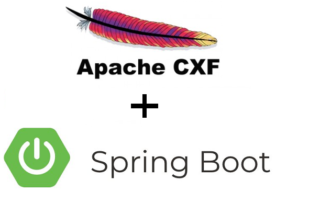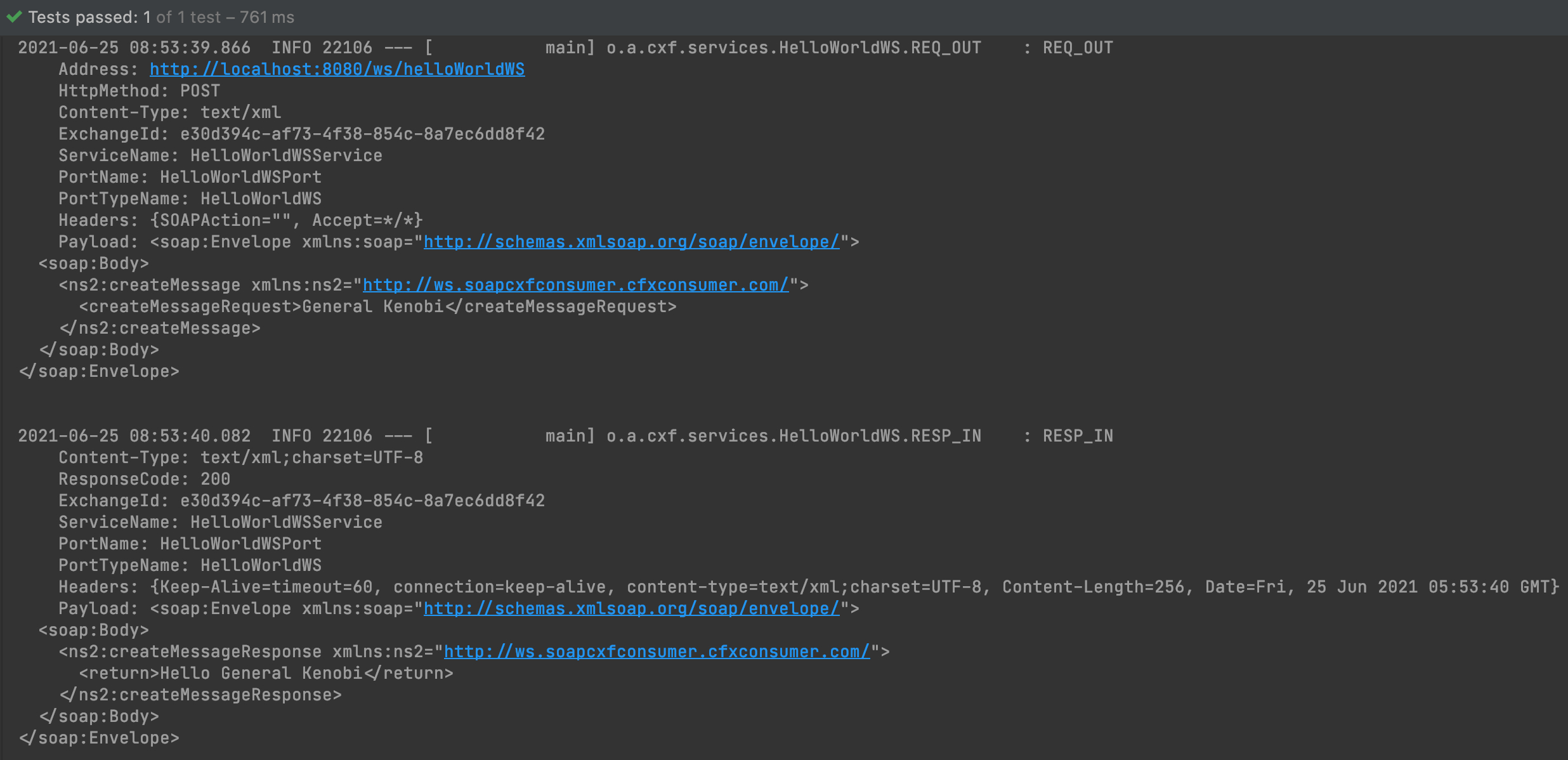Consuming SOAP Service With Apache CXF and Spring
A guide on how to consume SOAP web services with Apache CXF and Spring Boot. Plus, some extra information on making configurations and logging requests for CFX.
Join the DZone community and get the full member experience.
Join For Free
SOAP web services are not popular anymore but if you are working with old applications, you probably still have to deal with SOAP web services. I am going to give you an example of how to consume a SOAP service with CXF, how to make a configuration for it, and how to log requests and responses to it.
A Simple Web Service
Before I can consume a web service, I need a simple web service to work with. For the project, I am going to use Spring Boot version 2.5.0 and Java 11. You can use another version if you like; it does not matter as long as the versions are not too old. You can easily create a Spring Boot project with a Spring Initializer. If you use maven, pom.xml should be like this. If you use Java 8, you do not need to have a "JAXB Runtime" dependency.
<?xml version="1.0" encoding="UTF-8"?>
<project xmlns="http://maven.apache.org/POM/4.0.0" xmlns:xsi="http://www.w3.org/2001/XMLSchema-instance"
xsi:schemaLocation="http://maven.apache.org/POM/4.0.0 https://maven.apache.org/xsd/maven-4.0.0.xsd">
<modelVersion>4.0.0</modelVersion>
<parent>
<groupId>org.springframework.boot</groupId>
<artifactId>spring-boot-starter-parent</artifactId>
<version>2.5.0</version>
<relativePath/> <!-- lookup parent from repository -->
</parent>
<groupId>com.cfxconsumer</groupId>
<artifactId>soapcxfconsumer</artifactId>
<version>0.0.1-SNAPSHOT</version>
<name>soapcxfconsumer</name>
<description>Demo spring project for soap consuming with apache cxf</description>
<properties>
<java.version>11</java.version>
<cxf.version>3.3.3</cxf.version>
</properties>
<dependencies>
<dependency>
<groupId>org.springframework.boot</groupId>
<artifactId>spring-boot-starter-web-services</artifactId>
</dependency>
<dependency>
<groupId>org.springframework.boot</groupId>
<artifactId>spring-boot-starter-validation</artifactId>
</dependency>
<dependency>
<groupId>org.springframework.boot</groupId>
<artifactId>spring-boot-starter-logging</artifactId>
</dependency>
<dependency>
<groupId>org.springframework.boot</groupId>
<artifactId>spring-boot-starter-test</artifactId>
<scope>test</scope>
</dependency>
<dependency>
<groupId>org.glassfish.jaxb</groupId>
<artifactId>jaxb-runtime</artifactId>
</dependency>
<dependency>
<groupId>org.apache.cxf</groupId>
<artifactId>cxf-spring-boot-starter-jaxws</artifactId>
<version>${cxf.version}</version>
</dependency>
<dependency>
<groupId>org.apache.cxf</groupId>
<artifactId>cxf-rt-features-logging</artifactId>
<version>${cxf.version}</version>
</dependency>
</dependencies>
<build>
<plugins>
<plugin>
<groupId>org.springframework.boot</groupId>
<artifactId>spring-boot-maven-plugin</artifactId>
</plugin>
</plugins>
</build>
</project>First of all, I will create an interface for my simple web service like below. As you see, it will get a single string parameter and returns a string response.
@WebService
public interface HelloWorldWS {
@WebMethod
String createMessage(@WebParam(name = "createMessageRequest", mode = WebParam.Mode.IN) String name);
}And, now, I need an implementation of this interface. It will just add "Hello" in front of the input parameter and return it.
@Component
public class HelloWorldWSImpl implements HelloWorldWS{
@Override
public String createMessage(String name){
return "Hello "+name;
}
}This is not the topic of this article, so that's why I am not going into detail with CXF configuration. You just have to configure CXF like below.
import javax.xml.ws.Endpoint;
import org.apache.cxf.Bus;
import org.apache.cxf.jaxws.EndpointImpl;
import org.springframework.beans.factory.annotation.Autowired;
import org.springframework.boot.web.servlet.ServletRegistrationBean;
import org.springframework.context.annotation.Bean;
import org.springframework.context.annotation.Configuration;
import org.springframework.context.annotation.ImportResource;
import com.cfxconsumer.soapcxfconsumer.ws.HelloWorldWS;
@Configuration
@ImportResource({ "classpath:META-INF/cxf/cxf.xml" })
public class CxfWebServiceConfig {
@Autowired
private Bus cxfBus;
@Bean
public ServletRegistrationBean cxfServlet() {
org.apache.cxf.transport.servlet.CXFServlet cxfServlet = new org.apache.cxf.transport.servlet.CXFServlet();
ServletRegistrationBean servletDef = new ServletRegistrationBean<>(cxfServlet, "/ws/*");
servletDef.setLoadOnStartup(1);
return servletDef;
}
@Bean
public Endpoint helloWorldWebService(HelloWorldWS helloWorldWS) {
EndpointImpl endpoint = new EndpointImpl(cxfBus, helloWorldWS);
endpoint.setAddress("/helloWorldWS");
endpoint.publish();
return endpoint;
}
}Now, if I start my Spring Boot application, I can reach WSDL of my simple web service like this: http://localhost:8080/ws/helloWorldWS?wsdl
I will just write a test class to test my simple web service as below:
@SpringBootTest(webEnvironment = SpringBootTest.WebEnvironment.DEFINED_PORT)
public class HelloWorldWSIT {
private HelloWorldWS testClient;
@BeforeEach
public void init(){
JaxWsProxyFactoryBean jaxWsProxyFactory = new JaxWsProxyFactoryBean();
jaxWsProxyFactory.setServiceClass(HelloWorldWS.class);
jaxWsProxyFactory.setServiceName(new QName(
"http://ws.soapcxfconsumer.cfxconsumer.com/",
"HelloWorldWSImplService"
));
jaxWsProxyFactory.setAddress("http://localhost:8080/ws/helloWorldWS");
testClient = jaxWsProxyFactory.create(HelloWorldWS.class);
}
@Test
void name() {
System.out.println("soap response: "+ testClient.createMessage("General Kenobi"));
}
}As I run it, I see the below output. My web service works, now let's get to the point.

Web Service Client Consumer Configuration
If you like, you can start a new project like the previous one to consume the HelloWorld web service. Before consuming a web service, I need a client jar file. I am going to use wsimport utility to create a client jar file, with a command like this;
wsimport -clientjar helloWorldWSClient.jar "http://localhost:8080/ws/helloWorldWS?wsdl"
Client jar is created and I need to add it to the project as a dependency. After that, I can create a CXF configuration for it like below:
import java.util.HashMap;
import java.util.Map;
import javax.xml.namespace.QName;
import javax.xml.ws.BindingProvider;
import org.apache.cxf.ext.logging.LoggingFeature;
import org.apache.cxf.jaxws.JaxWsProxyFactoryBean;
import org.springframework.beans.factory.annotation.Autowired;
import org.springframework.context.annotation.Bean;
import org.springframework.context.annotation.Configuration;
@Configuration
public class HelloWorldWSClientConfig {
@Bean
public LoggingFeature loggingFeature() {
LoggingFeature loggingFeature = new LoggingFeature();
loggingFeature.setPrettyLogging(true);
return loggingFeature;
}
@Bean(name = "helloWorldWSClient")
public HelloWorldWS helloWorldWSService(@Autowired LoggingFeature loggingFeature){
JaxWsProxyFactoryBean fb = new JaxWsProxyFactoryBean();
fb.setServiceClass(HelloWorldWS.class);
fb.setWsdlLocation("/META-INF/wsdl/HelloWorldWSService.wsdl");
fb.setServiceName(new QName("http://ws.soapcxfconsumer.cfxconsumer.com/",
"HelloWorldWSImplService"));
Map<String, Object> properties = fb.getProperties();
if(properties == null){
properties = new HashMap<>();
}
properties.put("javax.xml.ws.client.connectionTimeout", 5000);
properties.put("javax.xml.ws.client.receiveTimeout", 3000);
fb.setProperties(properties);
fb.getFeatures().add(loggingFeature);
HelloWorldWS theService = (HelloWorldWS) fb.create();
BindingProvider bindingProvider = (BindingProvider) theService;
bindingProvider.getRequestContext().put(BindingProvider.ENDPOINT_ADDRESS_PROPERTY, "http://localhost:8080/ws/helloWorldWS");
return theService;
}
}I created a bean name as helloWorldWSClient, as you see. HelloWorldWS.class is the service class included in the client jar file. WSDL location is the path of the WSDL file in the jar file. serviceName consists of namespace and port name. You can put some configuration parameters into the properties map (like connection and socket timeout values). And the last thing to do is to set the endpoint of the service.
The LoggingFeature is required to log outgoing requests and incoming responses. If you want to log them you just have to put the below line into the application.properties file:
logging.level.org.apache.cxf.services = INFO
This will cause all CXF clients to log requests and responses. If you want to log only a specific service, then you need to have log configs like below.
logging.level.org.apache.cxf.services.HelloWorldWS.REQ_OUT = INFO
logging.level.org.apache.cxf.services.HelloWorldWS.RESP_IN = INFOAs it is obvious, you can use the service class name to log a specific service.
Consumer Web Service
Once the configuration is done, I am ready to call and consume our soap service. First of all, I am going to create a consumer service like below:
@Service
public class HelloWorldWSConsumerService {
private final HelloWorldWS helloWorldWSClient;
public HelloWorldWSConsumerService(HelloWorldWS helloWorldWS){
this.helloWorldWSClient = helloWorldWS;
}
public String callHelloWorld(String name){
return helloWorldWSClient.createMessage(name);
}
}Now, I need to test this consumer service. I am going to write a simple test class with a simple assertion.
@SpringBootTest(webEnvironment = SpringBootTest.WebEnvironment.RANDOM_PORT)
public class HelloWorldWSConsumerServiceIT {
@Autowired
private HelloWorldWSConsumerService helloWorldWSConsumerService;
@Test
void testCallHelloWorld() {
Assertions.assertEquals("Hello General Kenobi",
helloWorldWSConsumerService.callHelloWorld("General Kenobi"));
}
}After running this test, let's look at the console output.

That's all.
Opinions expressed by DZone contributors are their own.

Comments